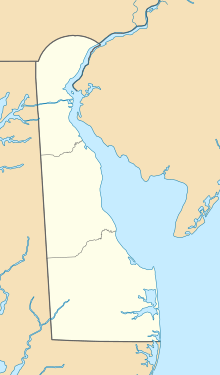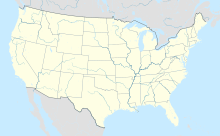Fort Saulsbury facts for kids
Quick facts for kids Fort Saulsbury |
|
|---|---|
| Part of Harbor Defenses of the Delaware | |
| Slaughter Beach, Delaware | |

A 12-inch M1895 gun at Fort Mills, Corregidor, Philippines. The guns at Fort Saulsbury were similar.
|
|
| Coordinates | 38°56′03″N 75°19′50″W / 38.93417°N 75.33056°W |
| Type | Coastal Defense and POW camp |
| Site information | |
| Owner | private |
| Controlled by | private |
| Open to the public |
no |
| Site history | |
| Built | 1924 |
| Built by | United States Army |
| In use | 1924-1946 |
| Battles/wars | World War II |
Fort Saulsbury was an old fort built by the United States Army to protect the coast. It was located near Slaughter Beach, Delaware and Milford, Delaware. From 1924 to 1943, it was the main fort protecting the Delaware Bay area with its big guns.
Later, in 1943, even bigger guns at Fort Miles in Cape Henlopen, Delaware took over its job. Some of Fort Saulsbury's guns were even moved to Fort Miles. Fort Saulsbury was named after Willard Saulsbury, Sr., who used to be a US Senator from Delaware.
Contents
History of Fort Saulsbury
After the United States built many forts to protect its coasts, new threats appeared. By 1915, powerful new warships called "dreadnought battleships" were being built. These ships were so strong they could make the older forts seem weak.
One problem was that the old gun mounts, called "disappearing carriages," couldn't aim the guns very high. This limited how far the guns could shoot. A new type of mount, the M1917 high-angle barbette carriage, was designed. It could raise the guns to 35 degrees. This made the existing 12-inch M1895 guns shoot much farther, from about 18,400 yards (16,825 meters) to 30,100 yards (27,523 meters).
Construction began in 1917 on 14 new batteries with two guns each. Ten of these were on the US East Coast. Fort Saulsbury had two of these new batteries.
Protecting the Delaware Bay
Before Fort Saulsbury, the main forts protecting the Delaware Bay were Fort Delaware, Fort DuPont, and Fort Mott. These forts were located far north in the Delaware River because their guns had a short range.
The long-range guns at Fort Saulsbury allowed the military to stop enemy ships much farther south. Fort Saulsbury had two main parts: Battery Hall and Battery Haslet. Each battery had two 12-inch guns. They also had large bunkers made of concrete and earth for ammunition and fire control.
- Battery Hall was named after David Hall. He was a Revolutionary War officer and a former Governor of Delaware.
- Battery Haslet was named after John Haslet. He was also a Revolutionary War officer who died in the Battle of Princeton.
The guns at Fort Saulsbury were out in the open. This meant they could be attacked from the air. But the fort was built away from the coast, which probably helped hide it from ships at sea. Unlike other forts, Fort Saulsbury did not have smaller guns nearby. This was likely because it didn't have a minefield that needed protection from enemy minesweepers.
Both batteries were finished in 1920. However, they officially started service in 1924.
Fort Saulsbury During World War II
From its completion until 1939, Fort Saulsbury was mostly quiet, with only about eight people taking care of it. In 1939, they added eight administrative buildings. Around 1940, five tall towers were built to help the fort's gunners aim their shots. These "fire control towers" were located at South Bowers Beach, Big Stone Beach, Cedar Beach, Fowler's Beach, and Broadkill Beach. Today, only the Big Stone Beach tower is still standing.
In early 1943, the guns from Battery Haslet were moved to Battery 519 at Fort Miles.
During World War II, many older heavy guns were removed and scrapped. However, the long-range 12-inch batteries, like those at Fort Saulsbury, were often kept. Most of these batteries were covered with thick concrete to protect them from air attacks. But Fort Saulsbury was one of the few that was not covered. This means Fort Saulsbury is one of the best-preserved forts of its kind that still looks like it did originally.
Also during World War II, Fort Saulsbury was used as a prisoner-of-war camp. It held prisoners from Germany and Italy.
In 1946, after the war ended, Fort Saulsbury's guns were removed and scrapped. The fort was sold to a private owner in 1948.
Fort Saulsbury Today
Fort Saulsbury is now privately owned, so the public cannot visit it. The old gun batteries are still in good condition. The fire control tower at Big Stone Beach is also still there.
Images for kids




